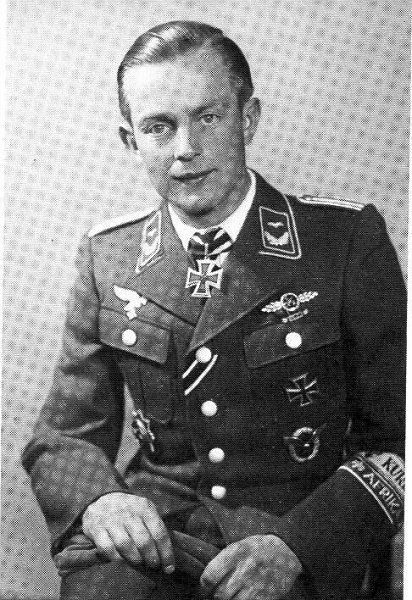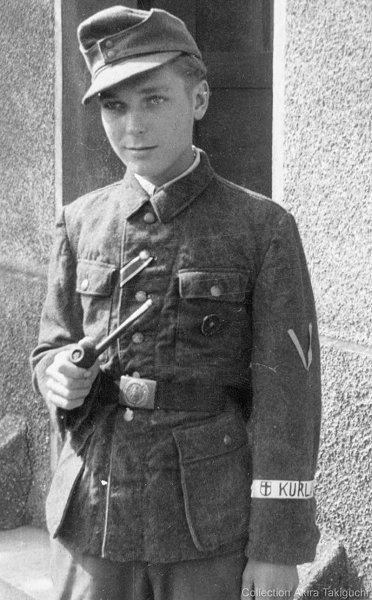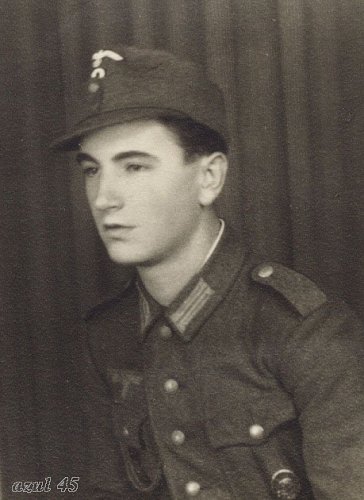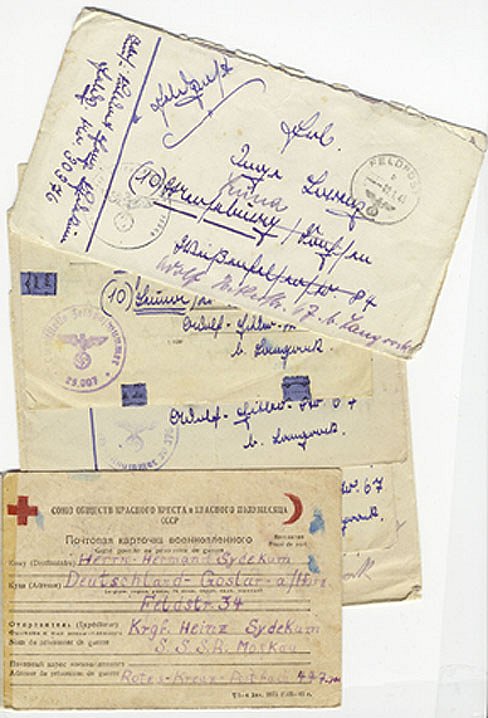
By Scott Pritchett
WEAR OF THE KURLAND BAND
|
|
This young Gefreiter properly wears the KURLAND band, which looks to be a full-length version. The absence of the breast eagle, cap eagle, collar litzen, and shoulder straps on his M43 uniform suggesst the soldier had the photo taken sometime after the war. His band looks non-standard and the title design somewhat simplified. It may be hand embroidered.
As noted earlier, photographs of the band in wear are extremely rare. With only a short life span this can be understood. The cuffband was properly worn on the left sleeve as a campaign decoration and could also be worn with either a unit cufftitle, as in he case of the Waffen SS, or another campaign award, in which case the older award took precedence and would properly be placed above the KURLAND band. The picture below shows Luftwaffe Knight’s Cross winner Kempken, who has properly sewn on his two campaign awards, with the KURLAND band above the AFRIKA band.
 |
| Courtesy/reproduced from Ritterkreuztraeger der Luftwaffe, by Oestermeir - via Jacques Calero. |
Correctly positioned, the band would be placed about 15-17 cm or 5.5-6
inches above the bottom edge of the sleeve. This would find the cuffband
always above the top edge of a turn back, French cuff by about 1-2 cm or
.5 inches on uniforms of this style. Bands sewn on the French cuff of
officer uniforms are not proper and in my opinion usually indicate
ignorance on the part of the person who sewed it on post war. The two
photos below show the band in wear. The picture on the left shows
Knights Cross winner Oberfeldwebel Max Jensen of I/G.R. 502/ 290.
Infanterie Division wearing what looks like the locally manufactured,
short version described above in detail. It may even be pinned on
judging from how loosely it is applied to his sleeve. The photograph on
the right is of Oberleutnant Bernt von Bock and would seem to be an
example of a full-length band in wear.
|
|
| Courtesy/reproduced from Ritterkreuztraeger der Luftwaffe, by Oestermeir - via Jacques Calero. |
Jensen won the decoration on 29.4.45 as a platoon leader and Feldwebel. The 290. I.D. was a very capable unit that fought in France and spearheaded the invasion of Russia. Trapped at Demyansk, it fought with both Army Group Center and Army Group North. The 290. I.D. arrived in the Courland Pocket in October 1944 and remained there fighting until the end of the war.
|
|
|
Previously published photo credited to AMiIltaria Magazine. |
Again, Gordon Williamson’s and McGuirls’ excellent book on cuffbands shows a photograph of Kriegsmarine sailor on page 65 wearing what looks most like a full-length embroidered style of the KURLAND band and a Luftwaffe officer, Knights Cross winner Leutnant Heinz-Georg Kempen, on page 52 shown wearing the KURLAND band along with an AFRIKA band. In this case, close scrutiny shows evidence that it may be the shortened machine woven style Kempen is wearing. No photos of a Waffen SS member wearing the band has surfaced.
The band would have been authorized for wear on field, service, parade dress and overcoat uniforms, as all campaign cuffbands were, except for the 1936 SPANIEN 1939 cuffband.
|
|
|
Courtesy Jacques Calero/ "photosammler". |
A very rare photo of the KURLAND band worn on the parade Waffenrock. The Officer and Ritterkreuztraeger is Hauptmann Günther Braake who commanded a battalion in the 422. Infanterie Regiment of the 126. Infanterie Division. The fact that Braake wears his parade uniform so close to the end of the war - within less than two months - is indicative of how military life continued in many ways, despite the imminent collapse of the Third Reich. On this occasion Braake was most probably on convalescent or authorized leave out of the bridgehead. Having already received the Wound Badge in Gold in May 1944, he was again wounded in December 1944 and yet again in February 1945. It is from this last wound that he may have been sent home recovering in March 1945.

A close up of a larger photo recently discovered and published in International Militaria Magazine showing the cuffband in wear by a single Oberfeldweble aboard what looks like an evacuation water craft probably somewhere vicinity of the Ostsee. It cannot be determined if this evacuation is part of the Courland bridgehead or some other location in the Baltics at the end of the war (courtesy IMM through “Polux” and Jacques Calero).
|
|
|
Courtesy Manuel R. collection. |
Heinz Sydekum awarded the KURLAND band on 20.4.45 – a common date of awarding of the cuffband. Sydekum’s unit suffered terribly throughout the war, seeing some of the heaviest fighting with the center and southern German armies in Russia. By 1943, his parent division, the 327. Infanterie Division, ceased to exist and the remnants of the unit were absorbed by other divisions. Some of these, in turn, were also destroyed. The 327. Heeres Pi. Bataillon eventually made it to Army Group Kurland, where Sydekum seems to have seen the war end, going in to Soviet captivity – Courtesy Manuel R. collection.
|
|
|
Courtesy Manuel R. collection |
Documents related to Sydekum attesting to his POW status in the hands of the Soviets -.
![]()
© Copyright Wehrmacht-Awards.com LLC |



